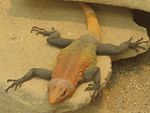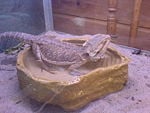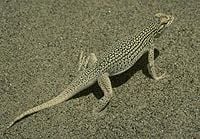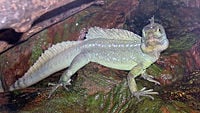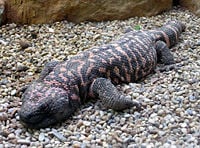| Lizard
| ||||||||||||
|---|---|---|---|---|---|---|---|---|---|---|---|---|
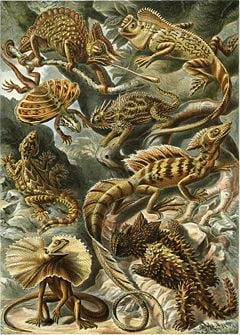 "Lacertilia", from Ernst Haeckel's Artforms of Nature, 1904
| ||||||||||||
| Scientific classification | ||||||||||||
| ||||||||||||
|
Many, see text. |
Lizard is any of the numerous reptiles of the suborder Sauria (or Lacertilia) of the order Squamata. Lizards generally are distinguished from snakes‚ÄĒwhich also belong to order Squamata, but are placed in suborder Serpentes‚ÄĒby the presence of legs, although some lizards are legless. Lizards also are differentiated from snakes by having external ear openings and typically movable eyelids.
Lizards are found in all continents except Antarctica, with one species even found in the Arctic Circle. However, lizards are most abundant in tropical areas. Some well-known types of lizards are iguanas, skinks, geckos, chameleons, gila monsters, and horned toads.
While advancing their own survival and reproduction, lizards also provide important benefits to human beings. In particular, they are significant predators of pest species, such as insects and rodents. Some, such as iguanas in Central America, are eaten as food, while a number of species are kept as pets. In addition, they add to the human enjoyment of nature, such as seeing the color change in a chameleon or the iridescent color in a skink. Very few lizards are harmful to people.
Description
The order Squamata is composed of lizards (suborder Squamata) and snakes (suborder Serpentes). Members of this reptilian order are distinguished by having a lower jaw that is not joined directly to the skull, scales, and the presence of paired reproductive organs in the male (Towle 1989).
Lizards have less flexible jaws than snakes, usually movable eyelids (although see geckos), external ear openings (although see chameleons), and most have four-well developed limbs, often with five toes on each foot. Lizards have an integumentary system comprised of scales, with a skull composed of quadrate bones. Some lizard species, including the glass lizard and legless lizards, lack functional legs although there are some vestigial structures. These are distinguished from true snakes by the presence of eyelids and ears and a tail that can sometimes break off as a physical defense mechanism. Lizards typically have a tail longer than the body and, like snakes, a chemosensory organ in the mouth.
Encompassing 40 families and about 3,000 species, lizards offer a tremendous variety in color, appearance, and size. Due to their smooth, shiny appearance, lizards can appear slimy or slippery; their skin is actually very dry due to a lack of pores to excrete lubricants. For example, lizards in the Scincomorpha superfamily, which include skinks (such as the blue-tailed skink), often have shiny, iridescent scales that appear moist. Like all other lizards, they are dry-skinned and generally prefer to avoid water. All lizards are capable of swimming if needed and a few (such as the Nile monitor) are quite comfortable in aquatic environments.
Most lizards are carnivorous, but preying on insects or small animals, such as rodents. However, some eat plants or are omnivorous.
Most lizards are oviparous (lay eggs, most buried in ground but some hatched as laid), though a few species are viviparous (live birth) where fertilization is internal. Many are also capable of regeneration of lost limbs or tails.
Many lizards can change color in response to their environments or in times of stress. The most familiar example is the chameleon, but more subtle color changes occur in other lizard species as well (most notably the anole, also known as the "house chameleon" or "chamele"). Anolis carolinensis, a common lizard of North America, can change color and is often called a chameleon, but true chameleons are limited to Africa and Madagascar.
The adult length of species within the order range from a few centimeters (some Caribbean geckos) to nearly three meters (komodo dragons). The Jaragua Sphaero or dwarf gecko, found on the island of Hispaniola in the Caribbean, measures just 1.6 centimetres (three-quarters of an inch) in length and is considered to be the world's smallest reptile (BBC 2001). Iguanas can reach one meter in length (Towle 1989). The Komodo dragon can reach 140 kilograms in weight.
Monitors (such as the Komodo dragon) are similar to snakes in that they have deeply forked tongues that serve as sense organs, and consume large prey whole (Towle 1989).
Diet and venom
As a group, lizards feed on a wide variety of foods, including fruits and vegetation, insects, small tetrapods, carrion, and even (in the cases of large predator lizards) large prey, such as deer.
Until very recently, it was thought that only two lizard species were venomous: the Mexican beaded lizard and the closely-related Gila monster, both of which live in northern Mexico and the southwest United States. However research at the University of Melbourne, Australia, and Pennsylvania State University has revealed that in fact many lizards in the iguanians and monitor families have venom-producing glands. Typically, these pose little danger to humans, as their poison is introduced slowly by chewing, rather than subcutaneous injection as with venomous snakes. Nine toxins previously thought to only occur in snakes have been discovered, as well as a number of previously unseen chemicals. Before this discovery, swelling and bleeding from lizard bites was believed due to bacterial infection but is now known to be due to venom injection. These findings have caused a re-evaluation of the classification system for lizard species to form a venom clade and may result in radical changes to the beliefs regarding the evolution of lizard, snake, and venom (Young 2005).
Relationship to humans
Most lizard species are harmless to humans. Most species native to North America, for example, are incapable even of drawing blood with their bites. Only the very largest lizard species pose threat of death; the Komodo dragon, for example, has been known to attack and kill humans and their livestock. The venom of the gila monster and beaded lizard is not deadly, but they can inflict extremely painful bites due to powerful jaws.
The chief impact of lizards on humans is positive. They are significant predators of pest species. In addition, numerous species are prominent in the pet trade, some are eaten as food (for example, iguanas in Central America), and lizard symbology plays important, though rarely predominant roles in some cultures (e.g. Tarrotarro in Australian mythology).
Species of lizards sold as pets include iguanas, bearded dragon, leopard geckos, tegus, and monitor lizards. In general, lizards require more maintenance than other exotic pets.
Classification
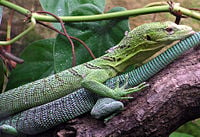 Green tree monitor lizard, Varanus prasinus |
Suborder Lacertilia (Sauria) - (Lizards)
- †Family Bavarisauridae
- †Family Eichstaettisauridae
- Infraorder Iguania
- †Family Arretosauridae
- †Family Euposauridae
- Family Corytophanidae (casquehead lizards)
- Family Iguanidae (iguanas and spinytail iguanas)
- Family Phrynosomatidae (earless, spiny, tree, side-blotched and horned lizards)
- Family Polychrotidae (anoles)
- Family Leiosauridae (see Polychrotinae)
- Family Tropiduridae (neotropical ground lizards)
- Family Liolaemidae (see Tropidurinae)
- Family Leiocephalidae (see Tropidurinae)
- Family Crotaphytidae (collared and leopard lizards)
- Family Opluridae (Madagascar iguanids)
- Family Hoplocercidae (wood lizards, clubtails)
- †Family Priscagamidae
- †Family Isodontosauridae
- Family Agamidae (agamas)
- Family Chamaeleonidae (chameleons)
- Infraorder Gekkota
- Family Gekkonidae (geckos)
- Family Pygopodidae (legless lizards)
- Family Dibamidae (blind lizards)
- Infraorder Scincomorpha
- †Family Paramacellodidae
- †Family Slavoiidae
- Family Scincidae (skinks)
- Family Cordylidae (spinytail lizards)
- Family Gerrhosauridae (plated lizards)
- Family Xantusiidae (night lizards)
- Family Lacertidae (wall lizards or true lizards)
- †Family Mongolochamopidae
- †Family Adamisauridae
- Family Teiidae (tegus and whiptails)
- Family Gymnophthalmidae (spectacled lizards)
- Infraorder Diploglossa
- Family Anguidae (glass lizards)
- Family Anniellidae (American legless lizards)
- Family Xenosauridae (knob-scaled lizards)
- Infraorder Platynota (Varanoidea)
- Family Varanidae (monitor lizards)
- Family Lanthanotidae (earless monitor lizards)
- Family Helodermatidae (gila monsters)
- †Family Mosasauridae (marine lizards)
ReferencesISBN links support NWE through referral fees
- British Broadcasting Corporation. 2001. Tiny Gecko is World's Smallest. BBC News. Retrieved August 10, 2007.
- Towle, A. 1989. Modern Biology. Austin, TX: Holt, Rinehart, and Winston. ISBN 0030139198.
- Young, E. 2005. Lizards' Poisonous Secret is Revealed. New Scientist. Retrieved June 2, 2007.
Credits
New World Encyclopedia writers and editors rewrote and completed the Wikipedia article in accordance with New World Encyclopedia standards. This article abides by terms of the Creative Commons CC-by-sa 3.0 License (CC-by-sa), which may be used and disseminated with proper attribution. Credit is due under the terms of this license that can reference both the New World Encyclopedia contributors and the selfless volunteer contributors of the Wikimedia Foundation. To cite this article click here for a list of acceptable citing formats.The history of earlier contributions by wikipedians is accessible to researchers here:
The history of this article since it was imported to New World Encyclopedia:
Note: Some restrictions may apply to use of individual images which are separately licensed.
